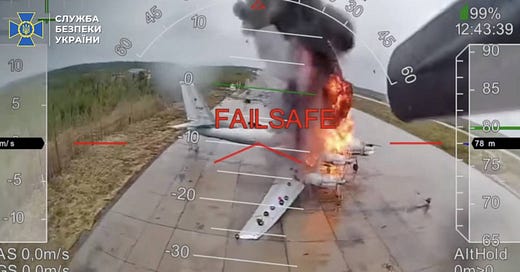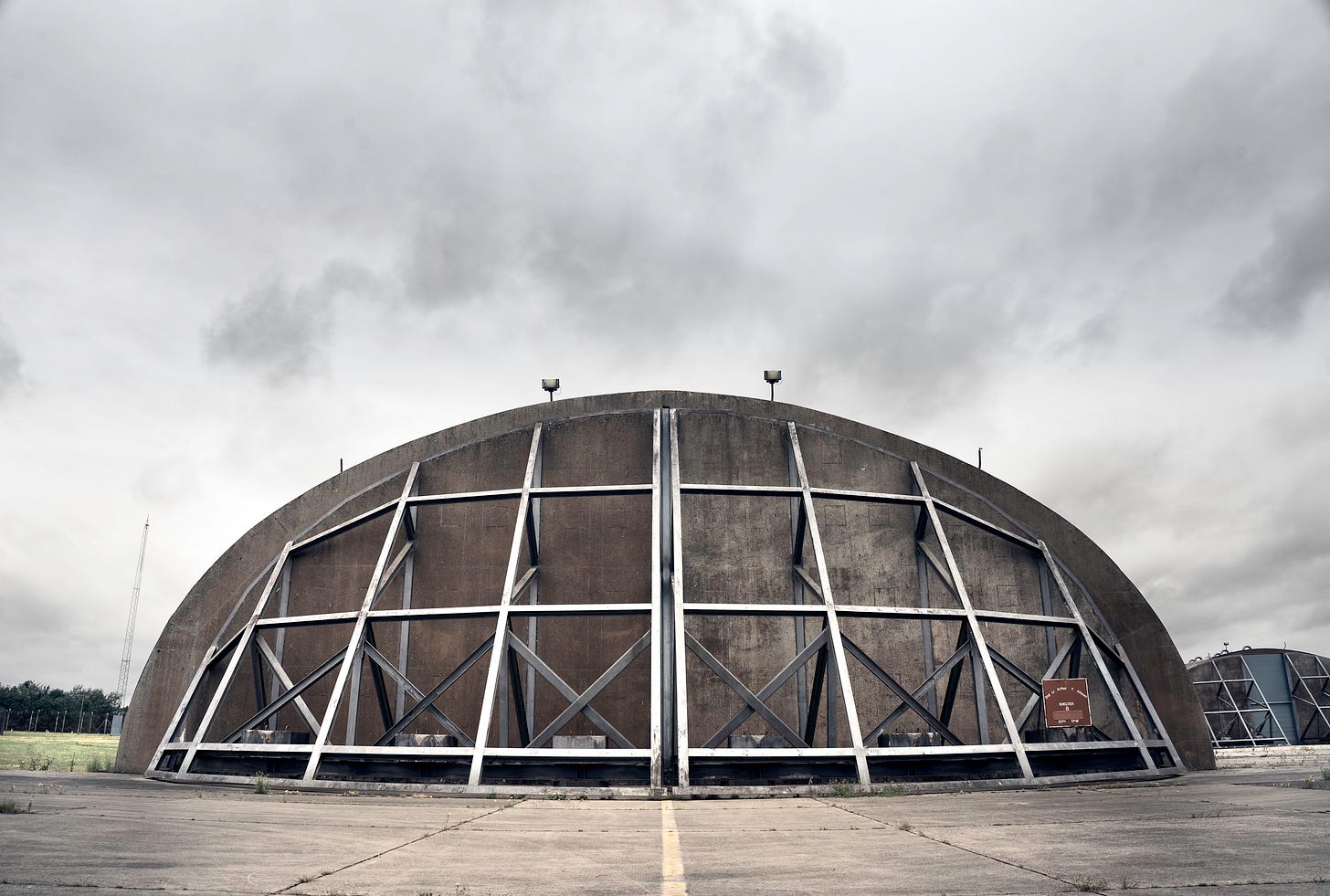The Wake‑Up Call
On June 1, 2025, in a coordinated operation known as "Operation Spider’s Web," Ukraine launched a massed drone attack against five Russian bomber bases, resulting in the destruction or damage of numerous high-value military aircraft, including Tu‑95 and Tu‑160 strategic bombers. Later, Israeli operatives conducted a coordinated drone strike from a covert base inside Iran in support of a larger campaign, employing small unmanned aerial vehicles to destroy surface‑to‑surface missile launchers aimed at Israel’s population centers. These attacks demonstrate that modest, expendable unmanned aircraft can generate disproportionate strategic effects, because of one key fact: small drones have in effect become detonators. They require no large warheads; they need only breach a platform or facility already containing vast stores of chemical energy, and then use that energy to catastrophic effect.
One need not think long or hard to identify similar targets across the United States—platforms and facilities whose fuel, munitions, or other volatile materials could be ignited, resulting in the destruction of high-value, difficult-to-replace American military assets.
Relevance to the Indo‑Pacific Contingency
China is the world’s largest drone manufacturer, accounting for approximately 70 percent of global civilian UAV shipments and People’s Liberation Army military doctrine emphasizes disabling the power‑projection assets of its "powerful enemy" by surprise. In the event a U.S. intervention in a future cross‑Strait crisis, American carrier air wings and forward airfields in Japan will likely face prompt ballistic‑ and cruise‑missile attack. As such, during the critical initial period—potentially measured in weeks—U.S. capacity to counter a fait accompli will depend heavily on continental‑United‑States‑based bombers and tankers departing from installations in the homeland. Should Chinese drone swarms destroy even a modest percentage of those aircraft while they are parked on the ramp, the outcome of the wider conflict could be fundamentally altered. And the ability for China to do so may well drive their calculus on whether to initiate such a conflict in the first place.
Ironically, the People’s Liberation Army has already addressed this vulnerability—albeit in reverse. A recent Hudson Institute study that I co‑authored determined that, since 2010, China has more than doubled its inventory of hardened aircraft shelters and now possesses in excess of 3,000 individual aircraft shelters. The United States, by contrast, continues to leave the vast majority of its most valuable aircraft exposed, relying instead on what Air Force leaders call "a multifaceted approach".
The Limits of Active Defense
Despite the urgency of the threat, there is little evidence the Department of Defense is moving decisively to address it. When asked recently about hardening efforts, Air Force leadership offered vague references to a "multifaceted approach". It is not enough to gesture at isolated, possibly ineffective protective measures. What is required is a national-level push to close a glaring vulnerability across the Department.
Although the Department of Defense is experimenting with high‑power microwave systems, electronic jammers, etc., experience in Ukraine demonstrates that no defensive architecture is impermeable. An adversary can simply increase the size of a drone swarm until the inevitable leakage produces a catastrophic result. Relying on perfect interception in a conflict of this scale is imprudent.
A Concrete Dome
This is a moment for urgent action. The risk is immediate and obvious, the vulnerabilities are glaring, and the cost of inaction could be strategic failure.
Priority Targets for Hardening
The facilities that demand immediate attention share three attributes: they are strategically valuable, they contain fuel or munitions whose ignition could yield catastrophic secondary explosions, and they would be indispensable in a U.S.–China conflict. Examples:
Bombers, airborne‑early‑warning aircraft, and other command‑and‑control platforms based in the continental United States form the backbone of America’s long‑range strike architecture. As many as possible should be housed in hardened aircraft shelters tailored to their size and mission.
Navy vertical‑launch systems—whether housed in the magazines of surface combatants berthed in port or in the tubes of submarines during reload—could share a single vulnerability: a shaped‑charge drone penetrating one cell could ignite propellant and set off sympathetic detonations, crippling a fleet’s striking power. Assessing and, if necessary, reducing this risk while ships and submarines are alongside the pier must also be an early priority for Concrete Dome.
Key petroleum, oil, and lubricants (POL) fueling sites should be hardened in a manner that limits the risk that a small UAV could ignite a fuel‑driven inferno.
Ammunition depots have been a common targets in recent drone wars. Reinforcing existing storage structures to resist penetration would sharply diminish the likelihood that stored ordnance could be ignited. This is particularly crucial for sites that house high-value weapons that could be key for a U.S.-China conflict: LRASM, JASSM-ER, and Mk 48 ADCAP torpedoes, for example.
Speed Should Take Precedence Over Perfection
In practical terms, a Concrete Dome effort should treat concrete and reinforcing steel as war‑critical commodities by invoking Defense Production Act authorities, enabling an industrial surge. Procurement could proceed under Section 804 “middle‑tier” authorities, permitting prototyping and production to advance without the usual delays. Commercially proven rapid‑construction methods could allow operational aircraft to benefit from hardened sheltering within months rather than years.
Any Concrete Dome effort should avoid the bureaucratic tendency to hand-wave and incorporate every emerging active‑defense technology. Its sole metric is straightforward: how many high‑value assets can we protect in an assured manner?All budgetary and managerial effort should advance that objective.
An Affordable Investment Compared With Potential Losses
Depending on dimensions, a hardened shelter costs between $4 million for a fully enclosed fighter shelter and approximately $30 million for a B‑21‑scale bomber shelter—sums that are minor when juxtaposed with the $600‑plus million unit cost of the B‑21 Raider. The economics are therefore compelling: concrete is inexpensive, whereas lost deterrence—and potentially lost warfighting capacity—is not.
The United States has previously demonstrated the ability to pour vast quantities of reinforced concrete under stringent timelines; the Pentagon was completed in sixteen months. With appropriate urgency, the nation can repeat such feats. The threat is no longer hypothetical; it has already manifested in other nations' homelands.
Note: this piece was written with the assistance of artificial intelligence







Taiwan would also be wise to heed this advice. (That is, if they wish to remain outside of direct PRC control... failure to take urgent action on these recommendations would speak forcefully to that point.)